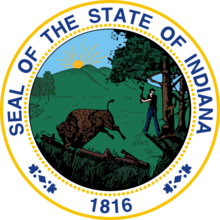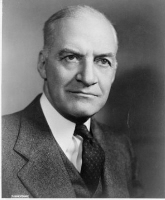Democracy in Action: Major Party Competition in US House Elections
Indiana has placed Democratic and Republican candidates on the ballot in a nation-best 180 consecutive U.S. House races, with New Hampshire, Minnesota, Idaho, and Montana all tallying 100 or more

Such a scenario often occurs in districts with lopsided partisan advantages or where long-serving incumbents have become shoo-ins for reelection.
In either case, democracy is not exactly at work when incumbents are rubber-stamped for another term. (And, to be sure, supporters of independents and third parties would say having only the two major party candidates on the ballot is not enough).
However, as the 2014 field begins to fill out across the nation’s 435 congressional districts, there are 10 states that will almost assuredly offer its voters a choice between a full slate of major party candidates on the ballot.
Five of these states have done so in 100 or more consecutive contests and the other five have done so in every House election dating back to at least 1954.
A Smart Politics review of congressional election data finds that Indiana, New Hampshire, Minnesota, Idaho, and Montana lead the nation with 100+ consecutive U.S. House general and special election contests offering both Democratic and Republican nominees on the ballot, with New Hampshire doing so in every such contest since the founding of the GOP more than 155 years ago.
Smart Politics tallied the number of uninterrupted general and special elections to the U.S. House through June 2013 in which each state fielded both a Democrat and a Republican in the race.
Seventeen states failed to do so in at least one congressional contest during the November 2012 elections: Alabama, Arizona, Arkansas, California, Colorado, Florida, Georgia, Kansas, Louisiana, Massachusetts, Mississippi, New Jersey (in a special election to its 10th CD), New York, Ohio, South Carolina, Tennessee, and Texas.
(South Carolina has since tallied a new streak of one in a row with its 1st CD special election in May 2013).
Many of these states, of course, are those with large populations where opportunities for gerrymandering districts (discouraging competition) are often more prevalent.
Head of the Class
By virtue of its nine seats on the ballot, Indiana overtook New Hampshire in the 2012 cycle for the largest number of consecutive races with both Democratic and Republican candidates at 180 straight U.S. House contests.
Indiana voters have had a choice of both major parties in each of the last 18 general election cycles dating back to 1978 as well as four special elections that have been conducted during this 35-year span.
The last time voters in Indiana did not have two major party candidates in a congressional race was in 1976 when Democrat Lee Hamilton ran unopposed in the state’s 9th CD contest en route to his seventh of 17 terms.
Although Republicans currently hold a 7-2 advantage over the Democrats in the Hoosier State U.S. House delegation, the two parties have been evenly matched during this span – with the GOP and Democrats both victorious in 90.
That said, not every district has been competitive during this four-decade stretch with Republicans turning out a candidate in the state’s 1st Congressional District despite Democrats winning all 19 races since 1978.
Democrats, meanwhile, have shown up to take their lumps in the 4th, 5th, and 6th CDs – fielding candidates while losing 47 of 55 House contests during this span.

(In the 1854 cycle, American Party candidates James Pike, Mason Tappan, and Aaron Cragin defeated Democrats in the state’s three districts).
While Democrats currently hold both of New Hampshire’s House seats in the 113th Congress, there has hardly been the general parity in the partisan makeup of the state delegation over these 175 races that Indiana has enjoyed over its 180.
In New Hampshire, Republicans have won 143 of the last 175 U.S. House contests since 1856, or 81.7 percent.
In other words, Democrats have been able to consistently field candidates to the state’s three (1856-1880) and then two (1882-present) congressional seats, even while winning less than one in five races across the last 157 years.
In general, many of the nation’s more sparsely populated states appear on the Top 10 list for turning out both major parties in congressional races, but the moderately-populated state of Minnesota comes in third at 136 straight races.
Minnesota has fielded Democrats and Republicans in every U.S. House race for 17 consecutive general election cycles dating back to 1980.

Unlike New Hampshire, where the GOP has dominated during its streak, it is the Democratic Party that has run up the score in Gopher State congressional races during this span, winning 85 of these 136 races (62 percent).
In fact, Minnesota’s streak is rather remarkable considering half of its congressional districts have been uncompetitive nearly every cycle during this stretch.
Republicans have come out of the woodwork each cycle only to be battered in the state’s 4th (Minneapolis) and 5th (St. Paul) CDs – losing all 34 races for these two seats since 1980.
The GOP has also lost 16 of the last 17 races in the 8th CD during this 17-cycle span.
Democratic candidates have won by an average victory margin of 29.6 points in the 4th, 41.5 points in the 5th, and 37.5 points during their 16 victories in the 8th.
The GOP, meanwhile, has won all 17 races in Minnesota’s 3rd CD, by an average margin of 35.7 points.
Two western states have also reached the 100-contest mark for Democrats and Republicans battling it out at the ballot box with Idaho at #4 and Montana at #5.
Idaho voters, though opting for the Republican candidate in 75 percent of U.S. House contests since the streak began in 1902, have had a Republican and Democratic option in each of these 107 contests.
The last time a Democrat or Republican failed to appear on the Idaho ballot was in 1900 when Populist Thomas Glenn won the state’s at-large seat against Republican John Morrison. (Glenn was one of five populists to win a House seat that cycle).
Republicans would go on to win all 11 of the Gem State’s at-large races from 1902 through 1916 as well as 30 of 48 contests in the 1st CD and 39 of 48 races in the 2nd CD thereafter.
In Montana, Republican Steve Daines’ victory over Kim Gillan last November marked the 100th consecutive House race in the state with both major parties on the ballot.
It has been 117 years since a major party failed to field a candidate in the Treasure State, when Republican and Silver Republican candidates squared off in the 1896 race for Montana’s at-large seat.

Former six-term Republican Frank Fellows was the last candidate in Maine to run without any major party opposition – doing so in the state’s 3rd Congressional District in 1942.
From 1944 through 2012 Republicans would go on to win 46 U.S. House seats in the Pine Tree State compared to 34 for the Democrats.
Maine’s Republican Party – still placing candidates on the ballot in the midst of its current 18-seat losing streak dating back to 1996 – won the final 10 seats in the 3rd CD from 1944 to 1960, 17 of 35 in the 1st CD, and 19 of 35 in the 2nd CD.
Rounding out the Top 10 states are South Dakota at #7 with 67 consecutive races (dating back to 1932), Delaware (1888) and Wyoming (1890) tied at #8 with 64, and North Dakota at #10 with 40 (1954).
Wyoming and Alaska (#15, 29 straight contests) are the only two states that have fielded Democratic and Republican candidates in every U.S. House race since statehood (with New Hampshire’s statehood date preceding the formation of the GOP).
Despite being on the wrong side of a partisan electorate, Democrats have always stepped up to the plate to take their licks over the decades in these two western states with Republicans winning 54 of 64 at-large races in Wyoming (84 percent) and 23 of 29 at-large contests in Alaska (79 percent).
The only heavily populated states (10+ U.S. House seats) that have fielded major party candidates in every race for at least the last two cycles are North Carolina, Illinois, and Michigan.
North Carolina (#11, 39 seats) has done so for three consecutive cycles dating back to 2008 while Illinois (#11, 39) and Michigan (#14, 30) have done so in each of the last two.
The filing deadline for the 2014 cycle is still many months away, so it remains to be seen which streaks, if any, will be broken that November.
Consecutive U.S. House Races with Both Democratic and Republican Candidates on the Ballot by State
|
Rank
|
State
|
Since
|
# Contests
|
|
1
|
Indiana
|
1978
|
180
|
|
2
|
New Hampshire
|
1856
|
175
|
|
3
|
Minnesota
|
1980
|
136
|
|
4
|
Idaho
|
1902
|
107
|
|
5
|
Montana
|
1898
|
100
|
|
6
|
Maine
|
1944
|
80
|
|
7
|
South Dakota
|
1932
|
67
|
|
8
|
Delaware
|
1888
|
64
|
|
8
|
Wyoming
|
1890
|
64
|
|
10
|
North Dakota
|
1954
|
40
|
|
11
|
North Carolina
|
2008
|
39
|
|
11
|
Illinois
|
2009
|
39
|
|
13
|
Iowa
|
2000
|
34
|
|
14
|
Michigan
|
2010
|
31
|
|
15
|
Alaska
|
1958
|
29
|
|
16
|
Hawaii
|
1990
|
28
|
|
17
|
Maryland
|
2008
|
25
|
|
18
|
Nevada
|
2000
|
22
|
|
18
|
Utah
|
2000
|
22
|
|
20
|
Pennsylvania
|
2012
|
18
|
|
21
|
Wisconsin
|
2010
|
16
|
|
22
|
Nebraska
|
2004
|
15
|
|
22
|
New Mexico
|
2004
|
15
|
|
22
|
Connecticut
|
2008
|
15
|
|
25
|
Kentucky
|
2010
|
13
|
|
26
|
Oregon
|
2010
|
11
|
|
26
|
Virginia
|
2012
|
11
|
|
26
|
Washington
|
2012
|
11
|
|
29
|
Missouri
|
2012
|
9
|
|
30
|
Rhode Island
|
2008
|
6
|
|
30
|
West Virginia
|
2010
|
6
|
|
32
|
Oklahoma
|
2012
|
5
|
|
33
|
Vermont
|
2010
|
2
|
|
34
|
South Carolina
|
2013
|
1
|
|
35
|
Alabama
|
—
|
0
|
|
35
|
Arizona
|
—
|
0
|
|
35
|
Arkansas
|
—
|
0
|
|
35
|
California
|
—
|
0
|
|
35
|
Colorado
|
—
|
0
|
|
35
|
Florida
|
—
|
0
|
|
35
|
Georgia
|
—
|
0
|
|
35
|
Kansas
|
—
|
0
|
|
35
|
Louisiana
|
—
|
0
|
|
35
|
Massachusetts
|
—
|
0
|
|
35
|
Mississippi
|
—
|
0
|
|
35
|
New Jersey
|
—
|
0
|
|
35
|
New York
|
—
|
0
|
|
35
|
Ohio
|
—
|
0
|
|
35
|
Tennessee
|
—
|
0
|
|
35
|
Texas
|
—
|
0
|
Note: Includes special elections through June 2013. Table compiled by Smart Politics.
Follow Smart Politics on Twitter.
